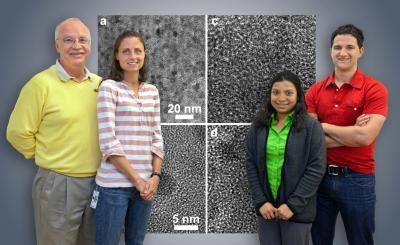
Hydrogen has been considered a viable alternative to fossil fuels for some time now. Hydrogen is lightweight and offers a higher energy density than gasoline. In addition, gasoline produces harmful greenhouse gases and pollutants while hydrogen's combustion by-product is water. The problem with using hydrogen on a larger scale is storage. It must be stored densely and safely, and must be easily accessible.
While many attempts in the past have failed -- such as packing large quantities of the gas into solids, which resulted in the solids only absorbing a small amount of hydrogen and requiring energy efficiency boosts through heating and cooling -- scientists have now created a new composite material for storing hydrogen without compromising density, safety or accessibility.
The material is made of nanoparticles of magnesium metal, which is scattered over a polymethyl methacrylate pattern. This design is capable of both absorbing and releasing hydrogen without oxidizing the metal after cycling, and at "modest" temperatures.
They were able to do this through the use of the TEAM 0.5 microscope at the National Center for Electron Microscopy (NCEM). The TEAM 0.5 is the world's most powerful electron microscope that possesses high-resolution imaging capabilities.
With the TEAM 0.5, researchers watched the magnesium nanocrystals spread throughout the polymer, and were able to observe any defects in the crystalline pattern, which offered a peek at how hydrogen acted within this new storage material.
"This work showcases our ability to design composite nanoscale materials that overcome fundamental thermodynamic and kinetic barriers to realize a materials combination that has been very elusive historically," said Urban. "Moreover, we are able to productively leverage the unique properties of both the polymer and nanoparticle in this new composite material, which may have broad applicability to related problems in other areas of energy research."
The team also utilized Berkeley Lab's Energy and Environmental Technologies Division (EETD) in order to test the uptake and release of hydrogen within the material. Through the use of the TEAM 0.5 microscope and EETD, the team was able to create a material that may successfully store hydrogen, allowing it to be used on a larger scale for batteries and fuel cells.
"Discovering new materials that could help us find a more sustainable energy solution is at the core of the Department of Energy's mission," said Kisielowski. "We confirmed the presence of hydrogen in this material through time-dependent spectroscopic investigations with the TEAM 0.5 microscope. This investigation suggests that even direct imaging of hydrogen columns in such materials can be attempted using the TEAM microscope."
This study was published in Nature Materials.



sott won't let me post a link, so look it up.